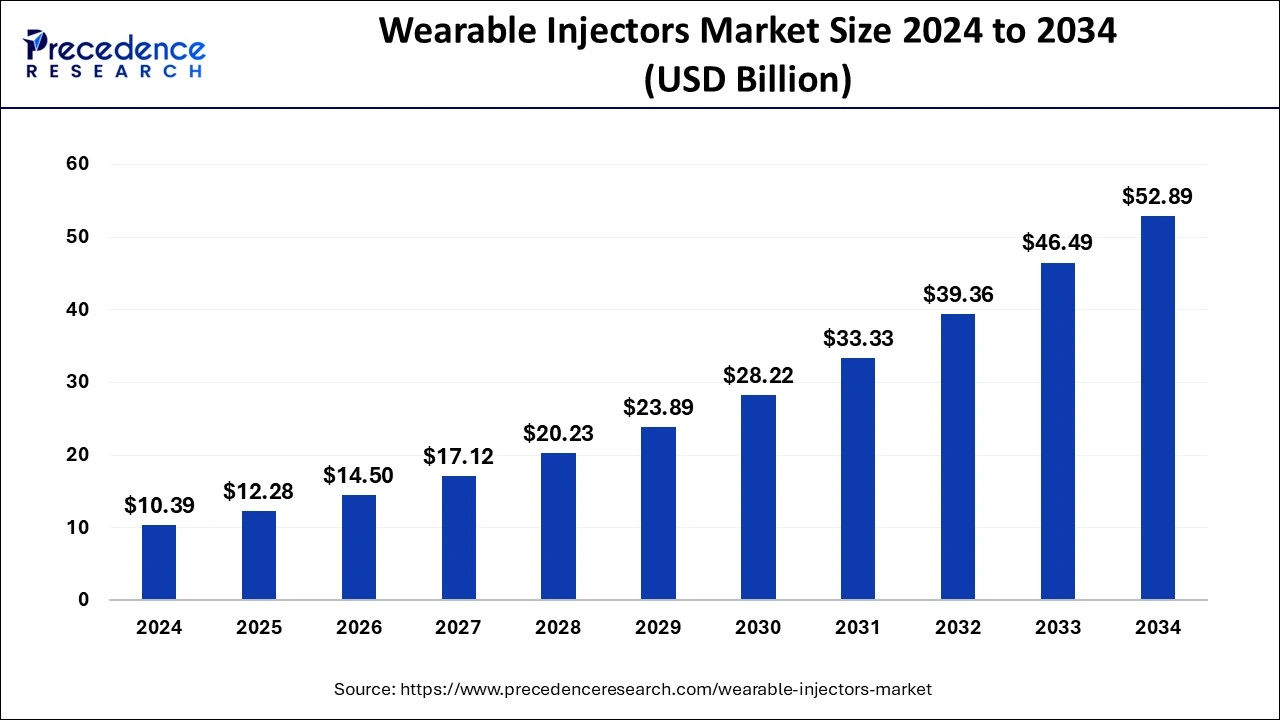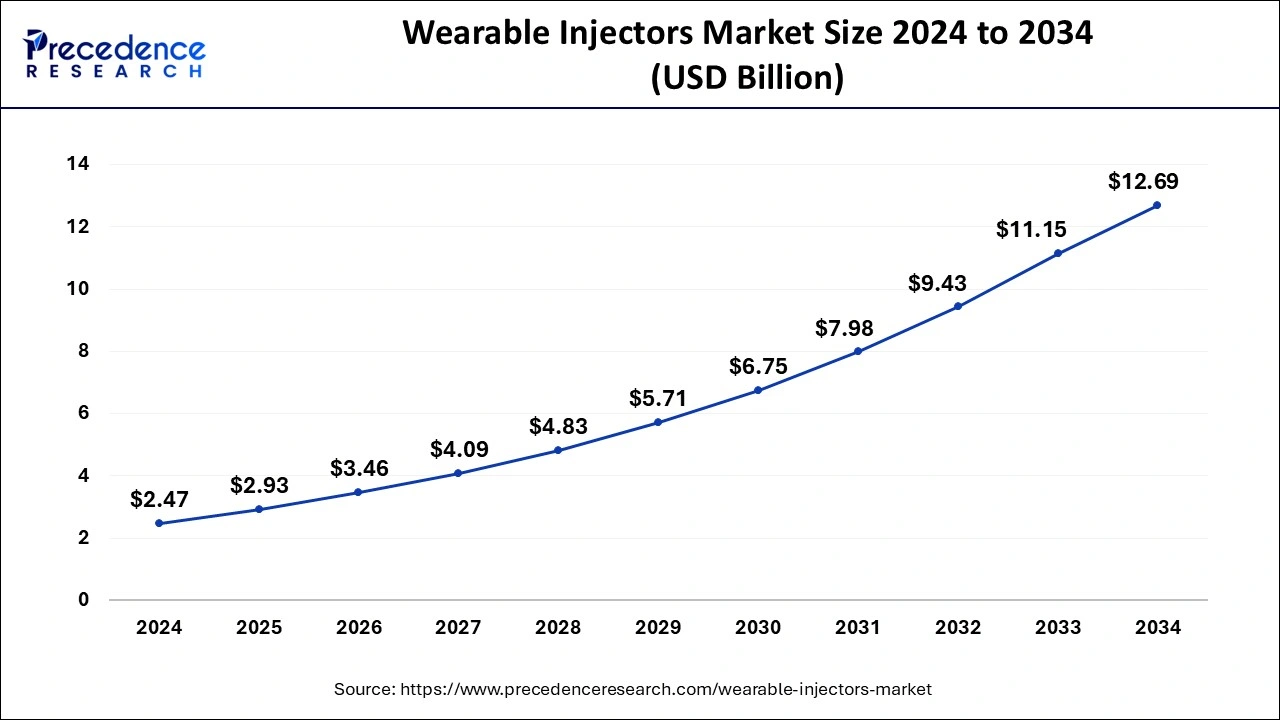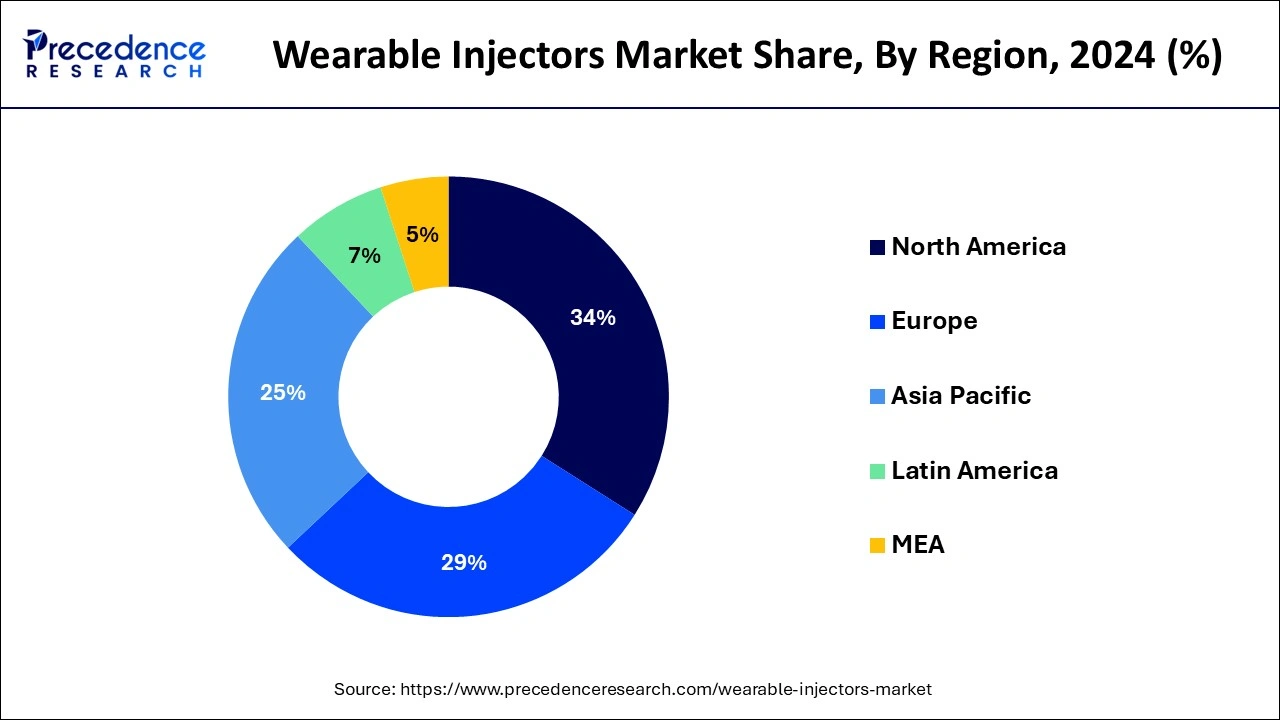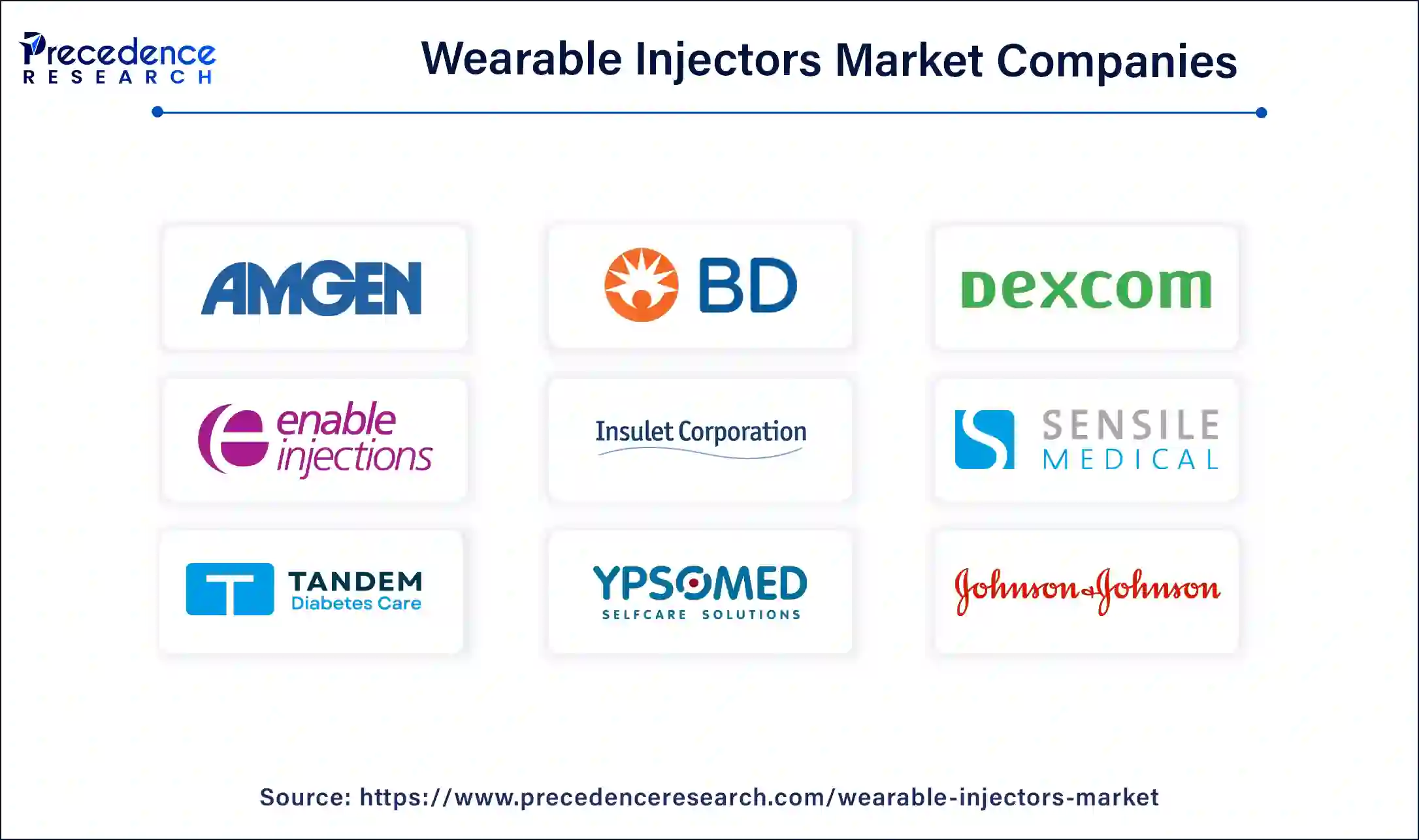List of Contents
Wearable Injectors Market Size and Forecast 2025 to 2034
The global wearable injectors market size was projected at USD 10.39 billion in 2024 and is anticipated to worth around USD 12.28 billion by 2025, to approximately USD 52.89 billion by 2034, growing at a CAGR of 17.67% from 2025 to 2034.

Wearable Injectors Market Key Takeways
- North America led the global market with the highest market share of 34% in 2024.
- Asia-Pacific is predicted to expand at the fastest CAGR during the forecast period.
- By Type, the on-body segment held the largest market share of 56% in 2024.
- By Type, the off-body segment is anticipated to grow at a remarkable CAGR during the projected period.
- By Application, the oncology segment had the biggest market share of 12% in 2024.
- By Application, the autoimmune diseases segment is estimated to expand at the fastest CAGR over the projected period.
- By End-use, the homecare segment contributed more than 81% of revenue share in 2024.
U.S. Wearable Injectors Market Size and Growth 2025 to 2034
The global wearable injectors market size was exhibited at USD 2.47 billion in 2024 and is expected to be worth around USD 12.69 billion by 2034, at a CAGR of 18% from 2025 to 2034.

North America is dominating the wearable injectors market in 2024. The advanced healthcare infrastructure of North America is accelerating the market. Advancement and innovation are initiating development in the healthcare sector, in terms of revenue and is estimated to sustain its dominance during the forecast period. This is attributed to the increased number of people suffering from various chronic diseases. According to a study, around 60% of the US population is suffering from at least one chronic disease. Moreover, the development of various innovative drugs that can effectively treat chronic diseases is fueling the demand for the wearable injector market. Moreover, the rising popularity of personalized medicines may impact the market positively in the forthcoming years.
United States Wearable Injectors Market Trends
The growing prevalence of chronic diseases like cardiovascular conditions, diabetes, and cancer increases demand for wearable injectors. The aging population and rising demand for higher healthcare solutions help in the market growth. The presence of a well-established healthcare system increases demand for wearable injectors. The strong presence of the pharmaceutical industry and growing drug innovation increases demand for innovative wearable injectors.
The supportive regulatory environment and growing healthcare spending drive the market growth. The favorable reimbursement policies and growing demand for home-based treatments increase the adoption of wearable injectors. The presence of strong market players like Johnson & Johnson, Becton, and Dickinson & Company supports the overall growth of the market.
Canada Wearable Injectors Market Trends
Canada is significantly growing in the wearable injectors market. The presence of a robust healthcare system and the growing adoption of new healthcare technologies increases demand for wearable injectors. The growing prevalence of chronic diseases like cancer and diabetes helps in the market growth. The aging population and growing chronic conditions in aged people drive the overall growth of the market.

Asia Pacific is estimated to be the most opportunistic market during the forecast period. Asia Pacific is home to several top biopharmaceutical manufacturers. The nations like India, China, and South Korea are expected to present lucrative opportunities to market players in the upcoming future. Moreover, the rising old-age population in the region is expected to drive the demand for wearable injectors. Geriatric people are more prone to various chronic diseases and are expected to foster market growth in the foreseeable future. According to the WHO, by 2050, around 80% of the geriatric population will be living in low and middle-income economies.
China's Wearable Injectors Market Trends
China is a major contributor to the wearable injectors market. The growing chronic conditions like autoimmune disorders, cardiovascular disease, and diabetes increase demand for wearable injectors for effective treatment. The growing geriatric population and rising chronic diseases in older adults help in the market growth. The growing preference for home healthcare and the growing government investment in healthcare increases demand for wearable injectors.
The growing research & development in drug delivery systems increases the production of wearable injectors. The strong government support and favorablereimbursement policies help in the market growth. The growing focus on personalised healthcare increases demand for wearable injectors, driving the overall growth of the market.
India Wearable Injectors Market Trends
India is growing in the wearable injectors market. The growing prevalence of chronic diseases like cardiovascular conditions, diabetes, and cancer in the nation increases demand for wearable injectors. The growing advancements in drug delivery technology help the overall growth of the market. The government investment in biotechnology research & development and the rising demand for patient-centric healthcare drive the overall growth of the market.
Market Overview
Wearable Injectors are medical devices that are worn on the body to inject drugs. They are an alternative to traditional syringes and are used to administer insulin to diabetes patients. The wearable injectors market is experiencing significant growth due to the rising trend of self-medication and the demand for home-based treatment. Thus, people are seeking ways to manage their health independently. However, these injectors allow people to take their medications on their own, reducing discomfort and improving overall health outcomes.
Technological Advancement
Technological advancements in the wearable injectors market feature smart technology integration, automated drug administration, and real-time monitoring. Automated drug administration automates the dosing system and improves drug delivery. Smart technologies and connectivity, such as WiFi and Bluetooth, activate the monitoring system of drug delivery and help healthcare providers and patients to access schedules and reminders. Real-time monitoring in wearable injectors gives exposure to valuable insights for both patients and healthcare providers. Needle-free injection systems are an advanced technology providing pain-free injections. Mobile applications and digital platforms allow tracking and reminders. This technology is highly contributing to the telehealth companies.
Patient-specific dosing enables personalized dose delivery, according to the patient's needs and treatment type. These technologies contribute to several other sectors as well as the wearable injectors market. The development is reshaping the future of healthcare and other medical facilities. Innovation and advancement are reaching the market to manage and adopt new work patterns with the help of technology.
Wearable Injectors Market Growth Factors
The inconveniences like needle stick injuries and limitations of traditional syringes have encouraged the adoption of the latest wearable injectors among the population. The wearable injectors eliminate the requirement of any assistance from healthcare workers and also reduce the consumer's expenditure on healthcare. Moreover, the wearable injectors are compact and portable and allow the patient to self-administer the drugs while conveniently doing regular tasks at home or office. All these benefits offered by wearable injectors are expected to drive the demand for wearable injectors among the population during the forecast period. Moreover, technological advancements led to the development of new and innovative drugs, which requires special drug delivery devices to efficiently administer the drugs in the patient's body. Thus rapidly growing biopharmaceutical industry is boosting the development of new and innovative drugs that subsequently fosters the growth of the global wearable injector market across the globe.
The global wearable injector market is primarily driven by the growing prevalence of various chronic diseases such as cancer, rheumatoid arthritis, diabetes, cardiovascular diseases, and other chronic diseases coupled with technological advancements in drug delivery devices. Moreover, CVD accounted for around 32% of global deaths in 2019. The rapid growth of the biopharmaceuticals and development of various drugs that can cure chronic diseases efficiently fostered the demand for drug delivery devices across the globe.
Market Scope
| Report Highlights | Details |
| Market Size BY 2034 | USD 52.89 Billion |
| Market Size in 2025 | USD 12.28 Billion |
| Market Size in 2024 | USD 10.39 Billion |
| Growth Rate from 2025 to 2034 | CAGR of 17.67% |
| Largest Market | North America |
| Base Year | 2024 |
| Forecast Period | 2025 to 2034 |
| Segments Covered | Type, Application, End User, Region |
| Regions Covered | North America, Europe, Asia-Pacific, Latin America, and Middle East & Africa |
Market Dynamics
Drivers
Chronic Disease Burden
The growing prevalence of chronic diseases, such as cancer, rheumatoid arthritis, diabetes, cardiovascular diseases, and other chronic diseases, is a major factor driving the global wearable injectors market. Some chronic diseases, such as dibetes, often require regular medication to manage symptoms, which significantly boosts the demand for wearable injectors. According to the World Health Organization (WHO), chronic diseases kill about 41 million people every year, which is equivalent to 74% of all deaths worldwide.
Restraint
High Cost
Wearable injectors are expensive, which may deter potential users from adopting them. This, in turn, limits their widespread adoption. Moreover, the availability of oral insulin as alternative method for drug delivery is expected to hamper the market. Oral insulin is easy to take, effective, and safe, thereby boosting their demand.
Opportunity
Technological Advancements
Technological advancements in drug delivery devices create immense opportunities in the wearable injectors market. Advancements in design are making drug delivery devices, including wearable injectors, user-friendly. Moreover, the rising demand for personalized treatments that can cure chronic diseases efficiently boosts the demand for drug delivery devices across the globe.
Type Insights
The on-body segment accounted for over 56% of the market share in 2024. The on-body wearable injectors are easy to wear and comfortable for the skin. This has led to the extensive adoption of on-body injectors, thereby propelling the growth of this segment. Moreover, the rising demand for home care is expected to boost the segment's growth in the forthcoming years.
The off-body is estimated to be the fastest-growing segment during the forecast period. The off-body wearable injectors eliminate certain inconveniences such as adhesive fitting on the skin, painful removal of injectors, and skin irritation. The rising investments in the development of enhanced off-body injectors are expected to drive the growth of this segment in the future.
Application Insights
The oncology segment dominated the global wearable injector market in 2024, in terms of revenue and is estimated to sustain its dominance during the forecast period. This is attributed to the increased prevalence of cancer among the population. The increased prevalence of various cancer such as breast cancer, lung cancer, bowel cancer, and womb cancer are the major drivers of this segment.
On the other hand, autoimmune diseases are estimated to be the most opportunistic segment during the forecast period. This can be attributed to the rising prevalence of diabetes among the population and the rising demand for wearable injectors over traditional insulin pumps. According to the World Health Organization, diabetes is the major cause of kidney failure, heart attacks, blindness, and stroke. Hence, the demand for the treatment for diabetes is expected to drive the growth of this segment.
End User Insights
The homecare segment accounted for over 41% of the market share in 2024. The increased awareness regarding wearable injectors and increasing preferences for self-injecting of drugs. Moreover, the reduction in the costs of healthcare associated with the homecare segment and the elimination of any assistance for the administration of drugs using wearable injectors are the major drivers of this segment.
Wearable Injectors Market Companies

- Amgen
- Becton, Dickinson and Company
- Dexcom, Inc.
- Enable Injections
- Insulet Corporation
- Sensile Medical
- Tandem Diabetes Care, Inc.
- Ypsomed
- F. Hoffmann-La Roche Ltd
- Johnson and Johnson Private Ltd
Recent Developments
- In August 2024, LTS LOHMANN Therapie-Systeme AG (LTS) and Grand River Aseptic Manufacturing (GRAM) entered a strategic alliance focused on sterile fill finish for containers used in LTS' Sorrel wearable injector devices. (Source - https://www.contractpharma.com)
- In April 2024, a Contract development manufacturing organization (CDMO) partnered with Ypsomed to invest in technology and infrastructure to propel the YpsoDose patch injector platform to market as a fully integrated solution for the subcutaneous self-administration of large volume injectables. (Source - https://www.bioprocessintl.com)
- In June 2023, a top German pharmaceutical company completed the purchase of an Israeli startup's “wearable injectors”, small medical devices that are secured to a patient's body and automatically deliver a set dose of a drug. (Source - https://nocamels.com)
- In May 2024, Enable Injections partnered with Viridian Therapeutics, Inc. to enhance patient experience using enFuse, an innovative wearable drug delivery system.
- In April 2024, Medtronic introduced a wearable injector that can be worn by patients for 7 days for the treatment of diabetes.
Segments Covered in the Report
By Type
- On-Body
- Off-Body
- Hand Held
By Application
- Oncology
- Cardiovascular Diseases
- Infectious Diseases
- Autoimmune Diseases
- Others
By End User
- Hospitals
- Clinics
- Homecare
- Others
By Region
- North America
- Latin America
- Europe
- Asia-pacific
- Middle and East Africa
For inquiries regarding discounts, bulk purchases, or customization requests, please contact us at sales@precedenceresearch.com
Frequently Asked Questions
Ask For Sample
No cookie-cutter, only authentic analysis – take the 1st step to become a Precedence Research client